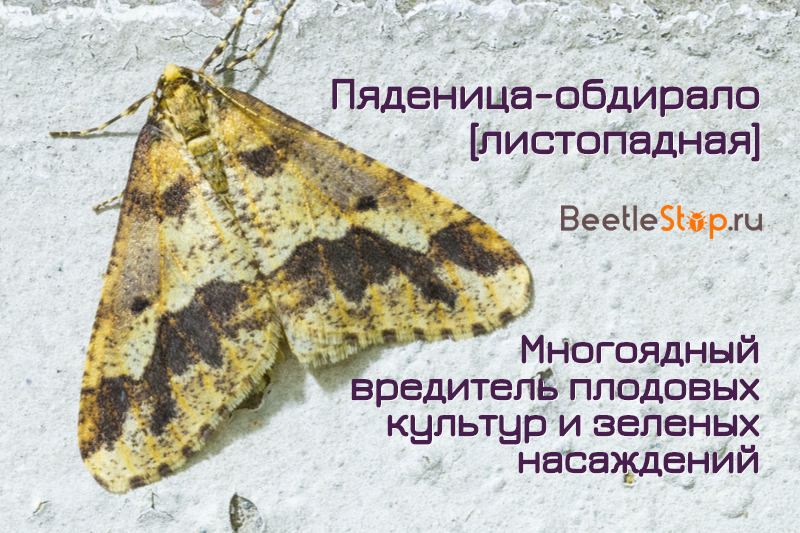Moth-peeled - pest of oak groves and gardens
Moths are a large family of Lepidoptera, including 23 thousand species. Small butterflies with a size of 30-50 mm are distinguished by a thin body and weak wings. The main distinguishing feature of the family is the underdeveloped abdominal legs of the caterpillar. This feature makes the larvae move in a peculiar way - the body bends upward with a loop, and the abdominal legs are pulled to the chest limbs. The moth was peeled - one of the species that are pests of fruit trees and green spaces. Fighting caterpillars includes agrotechnical and chemical methods that allow the eradication of a multi-eating insect.

View description
The moth-peeled or deciduous moth (Hyberniadefoliaria) is found in Europe, Siberia, and the Far East. In the south, butterflies live in the Crimea and the Caucasus. In insects, sexual dimorphism is clearly manifested. The male has a slender body with two pairs of wings. Anterior triangular, yellow or brown-yellow in color with two dark wavy transverse stripes. In the central part is a black spot. The hind wings are rounded, light yellow with a faint dark spot. Body size 22-25 mm, wingspan 40-45 mm. Butterfly coloration may vary.
The female is wingless, with a thick body and long limbs. The main color is yellow or gray, chest and abdomen are covered with black spots. The filiform tendrils and legs are also variegated, yellow and black patches alternate. The length of the female is 11-14 mm.
Lifestyle & Reproduction
The moth peeled off begins in September and is active until the end of October. Males in autumn nights circle at the tops of trees. Females sit on trunks and branches, waiting for mating partners. Their wings are reduced, so insects move with the help of their legs. Fertilized females lay eggs near the kidneys, in the cracks of the cortex, the internodes of the branches. Masonry takes place in groups of 3-20 pieces. Butterfly fertility is up to 200-300 eggs.
The shape of the egg is oval, size 0.9 × 0.5 mm. The initial color is light yellow, then darkens to orange. Eggs winter, in severe frosts (-30-35 °), embryos die. One generation of insects develops per year. Caterpillars appear in April, there are two forms - dark-colored and light-colored, between them several transitional forms. The length of an adult caterpillar of the fifth age is 35 mm. In the light form, the upper part of the body is red-brown with black stripes, the lower yellow. Black lines occupy almost the entire back of dark-colored larvae; dark spots are observed on the abdomen.
The head has the shape of a heart, on the crown of the head a small notch. The rough body is covered with granules. The moth larva has 5 pairs of legs, 3 pairs less than other caterpillars. This explains their special way of moving with arching the body and alternately moving the chest and abdominal legs. The larvae have well-developed muscles, they can still hold the body of a raised body, simulating a twig. Caterpillars eat the buds, ovary, leaves. Pests are extremely gluttonous, they need a large amount of green foliage.
The development of caterpillars takes 3-4 months; in June or July they descend for pupation. Insects burrow into the soil and build an earthen cocoon. Dolly slender, shiny, red-brown. Its length is 15 mm.The pupal stage lasts 2-3 months. In the beginning of autumn, adults are selected from the earth. Males begin years at night, females creep into the trees along the trunk.
Information. Like all nocturnal moths, male moths-peeled actively fly into the light of electric lamps.
Malware
Caterpillars of the moth are omnivores, they harm any fruit trees in the gardens: pear, cherry, apple, cherry. In the forests they feed on deciduous trees, prefer oak. In addition, they feed on rose hips, mountain ash, beech, elm, maple, birch and many other plants.
Attention. Periodically there are outbreaks of mass reproduction of the moth-peeled. Usually they coincide with the invasion of the winter moth. Pests live on the same cultures.
The number of moths is monitored using light and glue traps. Males fly to lamps with ultraviolet rays, and females fall into glue rings during the period of crawling onto trees. In August, pupae are weighed to determine the number of males and females. Research helps prevent mass reproduction of pests. One outbreak can last up to 8 years.
Pest Management Methods
To destroy the pest requires an integrated approach, consisting of several control methods:
Mechanical way
On a personal plot, laborious, but safe measures for the destruction of insects are used:
- In the morning, under the crowns of infected trees, a film is spread, then branches are shaken so that caterpillars fall. Collected pests are destroyed.
- The trunk of a fruit tree is wrapped with a hunting belt. This is a dense fabric or cardboard covered with a layer of non-drying glue. Adhesive rings are installed at the end of summer; they do not allow young females to crawl to the top of the tree to lay eggs. In the fall, traps are removed and burned with adherent insects.
Agrotechnical measures
- Digging soil under trees and in aisles, not only in autumn but also in summer.
- Destruction of fallen leaves, in which moth pupae are hiding.
- Cleaning trunks from dry bark and moss, spring whitewashing of trunks.
Chemical treatment
With a large spread of pests, it will not be possible to cope with the tracks without insecticide treatment. Spraying is recommended for 5 eggs per 1 meter of branch. Chemicals are sprayed in the spring, before the trees bloom. To combat the moth use the following drugs: "Decis", "Karbofos", "Fitoverm", "Clonrin", "Tsiperus".
The moth-peeled has natural enemies parasitizing on caterpillars and pupae. These are tahini flies and riders. Attracting beneficial insects allows the planting of sunflower, clover.

